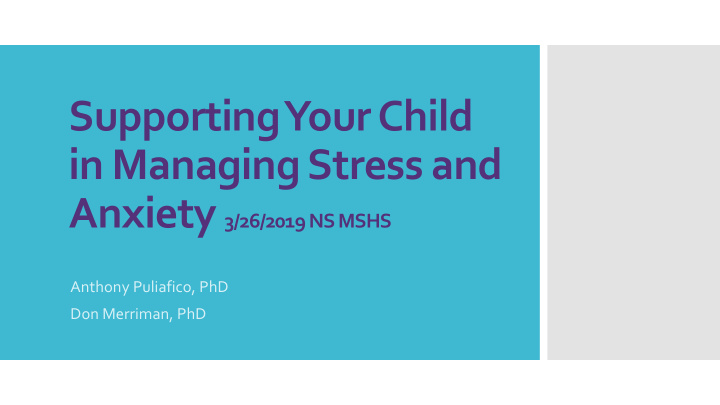



Supporting Your Child in Managing Stress and Anxiety 3/26/2019 NS MSHS Anthony Puliafico, PhD Don Merriman, PhD
Feelings of nervousness and fear in anticipation of a potential negative event Anxiety is universal What Is Anxiety? Anxiety is often adaptive Often hereditary, can be brought on by life events
When it leads to avoidance of important situations or life events When does When it causes impairment in areas of functioning • Academic anxiety • Social become a • Family/home disorder? When it causes significant distress
Excessive distress upon separation Separation May involve fear that something bad is going to anxiety happen when child and parent/caregiver are separated disorder Onset generally in early to mid-childhood
Excessive fear of negative evaluation/embarrassment in social situations Fear leads to either avoidance of feared situation or Social anxiety extreme distress while in situation disorder Often develops in late childhood, early adolescence
Excessive/uncontrollable worry about everyday life matters (school, performance situations, safety, etc.) Generalized • Physical symptoms (i.e. headaches, stomachaches, anxiety sleeplessness) accompany worry disorder • Youth with GAD often seem like “little adults”
Intrusive thoughts (obsessions) that are followed by repetitive behaviors (compulsions) intended to prevent harm and relieve anxiety Obsessive Thoughts may seem bizarre or illogical (fear of compulsive taking on another person’s essence) disorder May develop in childhood or adolescence
Specific Phobia Panic Disorder …and the rest Post Traumatic Stress Disorder
Extreme shyness Hesitant to participate in social situations What do we see at home Extreme discomfort when the center of attention and school? “Blends into the wallpaper” in social settings Calling/texting parents frequently
Trouble paying attention Extra time spent on homework, or avoiding it, due to perfectionistic concerns What do we see at home Always expecting the worst and school? Asks frequent questions Excessive worry about failure
• Trouble catching breath • Dizziness or lightheadedness • Stomachaches/ headaches • Heart racing Physical • Complains of nausea • Feeling faint symptoms of anxiety • Frequent trips to the bathroom • Feeling shaky or jittery • Tightness or pain in the chest • Sweating
Stress related to school, friendships or the future is normal . It is OK, and even important, for children to experience stress and learn how to handle it. Often anxiety worsens in children when they do not learn to face stressful situations. Managing your Offer to support child in managing stress, but discourage procrastination or escape. child’s stress at Balance validation with expectation “I know this situation is making you very nervous, and I know you home can handle it.” Maintain realistic expectations! “Perfect is the enemy of good”
Incorporate relaxing activities into your family’s regular schedule Family Game Night Reading before bed Mindfulness exercise Managing your Be a “coping model” Demonstrate that you also manage stressful situations throughout child’s stress at your day home Discuss situations in your day that raised your stress level, even if you did not handle it perfectly Tolerate your child’s distress
If your child frequently worries or gets anxious about schoolwork or attending school If your child avoids schoolwork or puts too much time into work When to seek If your child begins to resist attending school or tries to avoid certain aspects of school help at school? If you see any of these behaviors, please feel free to contact your child’s Counselor to begin a discussion on how the school and home can work together to help your child.
If a child’s anxiety or worry generalizes beyond the school setting When to seek If a child’s anxiety or worry is chronic or causing significant impairment or distress help outside of school? When recommended by school-based staff
Cognitive Behavioral Therapy Treatment Options for SSRI Medication Child Anxiety
Treatment focused on modifying behaviors and thoughts to reduce anxiety Cognitive Central component is gradual exposure to Behavioral anxiety-provoking situations Therapy (CBT) Therapist acts as a coach that teaches and guides child in using anxiety management skills
Prescribed by psychiatrist Common SSRI medications include Zoloft, SSRI Prozac, Luvox, Lexapro, Celexa and Paxil Medication Children typically take medication for at least 6 months
Dialectical Behavior Therapy Indicated for emotion dysregulation, or when youth is engaging in unsafe behaviors Other Treatment SNRI Medication: Effexor, Cymbalta, Options Pristiq
Anthony Puliafico, Ph.D. acp2137@cumc.columbia.edu Contact Us Don Merriman Email: dmerriman@northsalemschools.org x3077
Recommend
More recommend